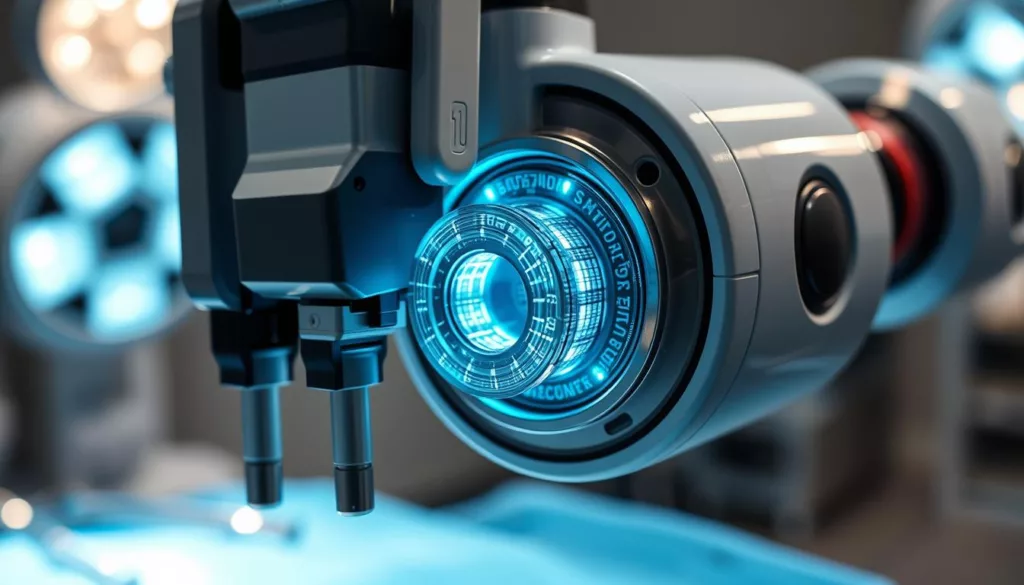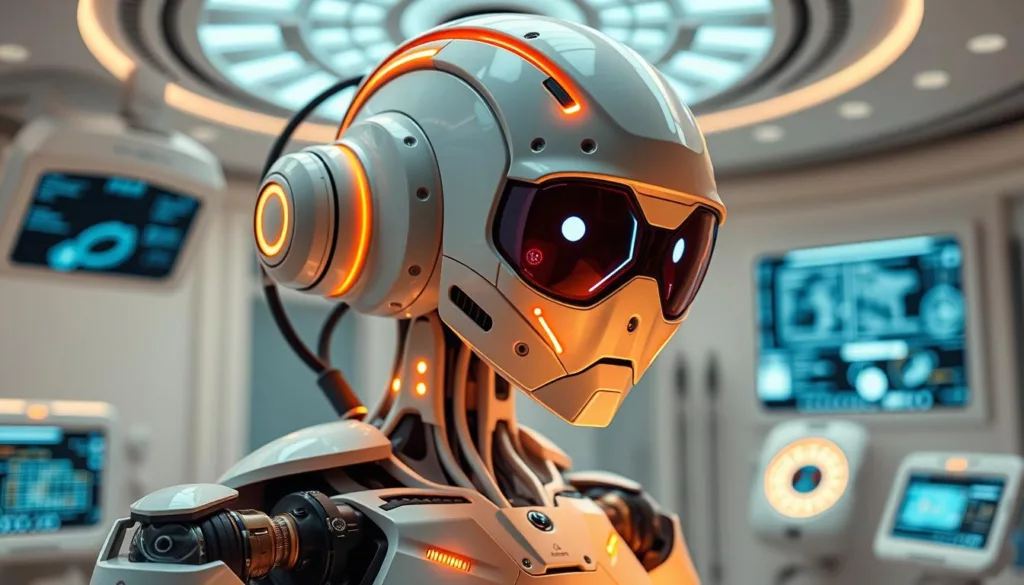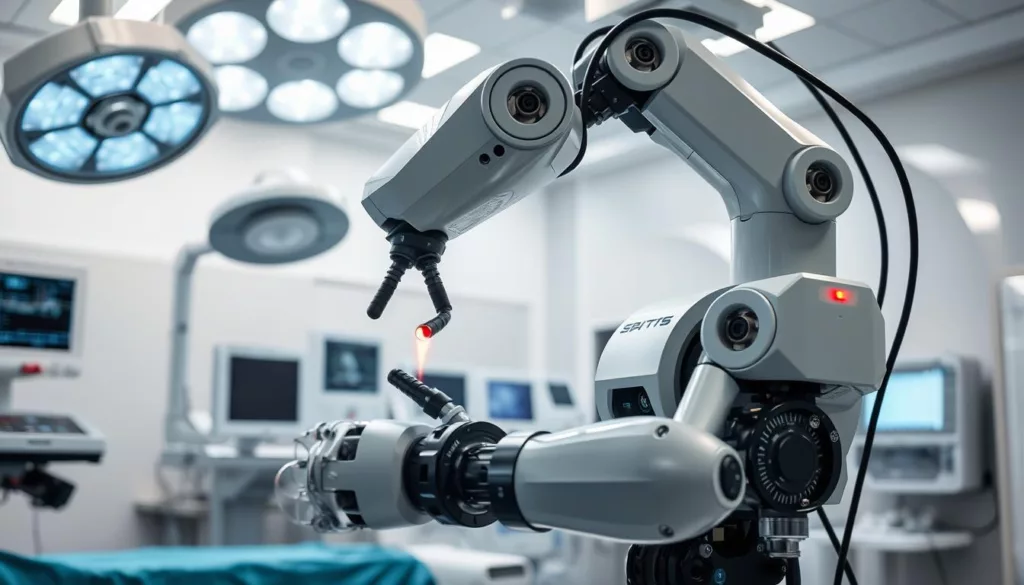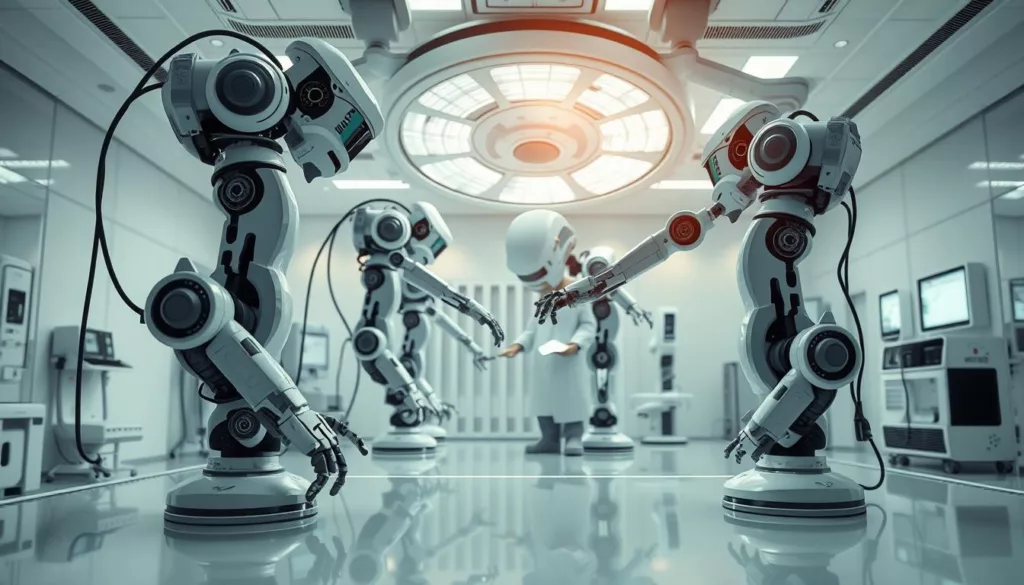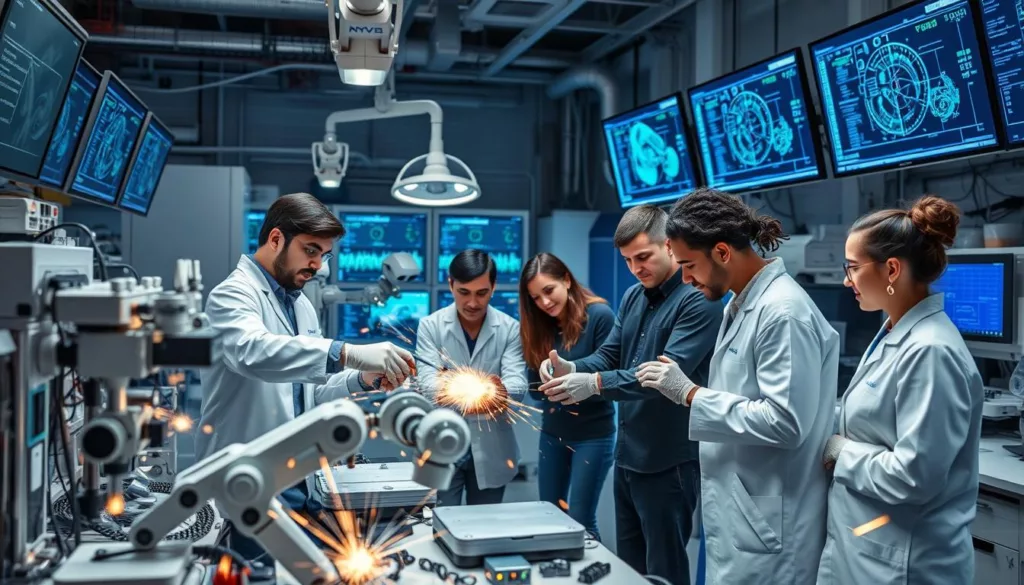In the ever-evolving world of surgical robotics, advanced motion sensors are key. They ensure safety and precision in surgeries. These high-precision sensors are crucial for healthcare automation solutions. They make robotic instruments more accurate.
The call for minimally invasive surgeries is on the rise. This has boosted the demand for these special sensors. Medical device suppliers strive for innovation in this area. They aim to provide solutions that meet industry standards and improve surgeries. Suppliers are putting money into new technologies. They want to make operations smoother and enhance patient care. Discover more about these sensor solutions.
Key Takeaways
- Advanced motion sensors are essential for precision in surgical robotics.
- The demand for minimally invasive surgery drives the need for high-precision sensors.
- Leading suppliers focus on innovation to enhance sensor capabilities.
- Custom solutions are key to meeting the varying needs in the surgical field.
- Healthcare automation solutions improve surgical efficacy and patient outcomes.
- Ongoing research and development are vital for future advancements in motion sensors.
Introduction to Motion Sensors in Surgical Robotics
In the world of surgical robotics, advanced motion sensors are key. They use motion tracking technology to make surgeries very precise. This precision is crucial. It leads to better results for patients and quicker recoveries.
Importance of Precision in Surgery
Precision is vital in surgeries. Any mistakes can cause complications. These complications can make recovery longer and impact the surgery’s success. Surgeons use precise positioning systems. This gives them the confidence to do complex surgeries. Using advanced sensors helps increase accuracy. It also lets surgeons do surgeries that are less harmful to patients.
Overview of Motion Sensor Technologies
Motion sensor tech includes devices like optical sensors, accelerometers, and gyroscopes. Each device has its own special role. It helps surgical robots work by giving real-time feedback. This feedback is needed for the robots to operate effectively. These sensors are crucial for surgical robotics. They let robotic systems work smoothly and give detailed data for moving in difficult situations.
| Sensor Type | Key Features | Applications in Surgery |
|---|---|---|
| Optical Sensors | High-resolution tracking, Depth perception | Guiding instruments in minimally invasive surgeries |
| Accelerometers | Motion detection, Orientation awareness | Stabilizing robotic arms for precise movements |
| Gyroscopes | Angular velocity measurement, Quick response time | Tracking rotational movements in surgical procedures |
Key Features of Advanced Motion Sensors
Advanced motion sensors are key in surgical robotics. They focus on improving how operations are done and making surgeries more precise. These features make the sensors very important in robotic surgery tools.
Sensitivity and Range
These sensors are made to be very sensitive and cover a wide area. They can pick up very small movements. This is crucial during surgery. Because they notice tiny changes, surgeons can be very accurate.
Data Processing Capabilities
Being able to process data quickly is a standout feature. These sensors use complex formulas to analyze data fast. This gives surgeons instant feedback, making surgeries safer and helping patients recover better.
Integration with Surgical Systems
Motion sensors must work well with surgical systems. They need to offer steady data access during operations. This compatibility makes things simpler for surgeons. It lets them fully use robotic surgery tools, improving safety and efficiency in the operating room.
Leading Suppliers of Advanced Motion Sensors
The market for advanced motion sensors in surgical robotics is growing fast. Several key medical equipment suppliers lead this fast-paced change. Their advancements in motion sensor technology play a big role in the healthcare sector, especially for surgeries.
This section discusses the leading players. It also looks at market trends influencing their success.
Overview of Major Players
Companies like Medtronic and Intuitive Surgical are at the top with their high-tech solutions. They work on fitting advanced motion sensors into surgical robots. This is key for better surgical accuracy and results.
The technologies these companies develop allow for immediate monitoring and feedback during surgeries. This boosts efficiency in operating rooms.
Market Share Trends
Analysis of market trends shows a competitive battle among top suppliers. Firms focusing on research to improve their motion sensor technologies tend to do better. Their commitment to innovation helps them grab a bigger market share, showing the value of innovation for staying ahead.
| Supplier | Market Share (%) | Key Technologies |
|---|---|---|
| Medtronic | 30 | Real-time imaging sensors, Robotics integration |
| Intuitive Surgical | 25 | Endoscopic camera systems, Motion feedback sensors |
| Stryker | 15 | Motion control algorithms, Sensor fusion technologies |
| Zimmer Biomet | 10 | Augmented reality for robot-assisted positioning |
| Others | 20 | Varied advanced sensor technologies |
Innovative Technologies in Motion Sensors
New motion sensor technologies are changing how robots are used in surgery. They improve precision and effectiveness greatly. This makes them very important for surgeries.
AI and Machine Learning Integration
Adding artificial intelligence and machine learning to motion sensors has changed surgical robots a lot. These technologies help with making quick, smart decisions during surgery. Robots can now adjust in real-time, leading to better results for patients.
Healthcare companies are putting these advanced features into their robots. This makes surgeries smarter and more adaptable. To learn more about how these technologies are used in robots, click here.
Miniaturization of Sensor Components
The trend of making sensor parts smaller is important. It lets companies create tiny components that still work very well. Small sensors help make robots that can go into tight spaces without losing accuracy.
This advancement not only makes surgical robots easier to use. It also lets them be used in many different healthcare situations. For more information on these sensor improvements, explore more here.
Applications of Motion Sensors in Surgical Robots
Advanced motion sensors are revolutionizing how surgeries are done. They bring precision and efficiency into the operating room. Everyday, these sensors become more essential in modern surgery.
Minimally Invasive Surgery
Today, minimally invasive surgery is key in medicine. With motion sensors, these operations become even more precise. This means surgeons can do complex work with less risk.
Thanks to this tech, patients have faster recovery times. They can get back to their daily lives sooner.
Robot-Assisted Surgery
Robot-assisted surgeries count on motion sensors for accuracy. These sensors help robots perform delicate tasks smoothly. This precise control improves surgeries and reduces strain on surgeons.
It allows surgeons to work on complex procedures without getting tired. This benefits both doctors and patients greatly.
| Application | Benefits | Impact on Recovery |
|---|---|---|
| Minimally Invasive Surgery | Improved precision and reduced risks | Shorter recovery times |
| Robot-Assisted Surgery | Enhanced stability and control | Less physical strain on surgeons |
Selection Criteria for Suppliers
Choosing the right supplier for advanced motion sensors in surgical robots is crucial. They must ensure high-quality solutions that focus on patient safety and operational excellence. It’s important to pick suppliers that meet industry standards and are up-to-date with technology.
Quality Assurance Standards
Suppliers need to follow strict quality assurance protocols. This guarantees sensor performance in surgical settings. Their commitment shows they produce reliable and accurate components for surgical robots.
R&D Capabilities
Strong research and development is key for suppliers to keep up with surgical robotics advancements. Those with a strong R&D focus can bring new technologies. This leads to better surgical results. To learn more about leading suppliers, check out this white paper that discusses Kollmorgen’s TBM2G series motors.
Companies like XJCSENSOR show how vital customizable solutions are. They adapt their technology to meet specific needs, focusing on product quality. For more information, visit XJCSENSOR.
Challenges Facing Sensor Suppliers
The field of advanced motion sensors for surgical robots is complex. It comes with many challenges for sensor suppliers. They must deal with strict compliance, regulatory rules, and supply chain problems.
Compliance and Regulations
For sensor suppliers, following the rules is crucial. They need to keep up with standards set by groups like the FDA. These standards manage how motion sensors are approved for the market. Going through these rules means lots of paperwork, tests, and checks. Doing this right means their products are safe and accepted for use in healthcare.
Supply Chain Issues
The global supply chain is facing hard times. This leads to problems getting high-quality sensors. Delays, lack of materials, and political problems make things worse. Suppliers must tackle these issues to keep delivering dependable products. Having a reliable supply chain helps them stay in the market and meet the growing need for new healthcare tools.
Case Studies: Successful Implementations
Many places have seen great results with sensors in their robot surgery systems. They offer valuable lessons for others interested in similar tech.
Institutions Leading the Way
Mayo Clinic and Cleveland Clinic are leaders in surgery robots. They use advanced sensors to make operations safer and more accurate. Their drive for new solutions has made them world leaders in using sensors in surgery.
Measurable Outcomes from Using Sensors
Research shows big benefits from using advanced motion sensors. Institutions report:
- Shorter recovery times, getting patients back to normal faster.
- Fewer complications, making surgery safer for everyone.
- Better accuracy in surgery, leading to improved health later on.
The smart use of sensors makes surgery better and care quality higher. It shows how tech helps hospitals make informed choices.
Future Trends in Motion Sensors
Motion sensors in surgical robotics are evolving fast, thanks to exciting new technologies. These trends are key for healthcare organizations aiming to boost their efficiency and the care they give. Let’s look at the tech that will change this field soon.
Emerging Technologies to Watch
Soon, several tech advancements could transform motion sensors in surgery robots. These include:
- Advanced Sensor Fusion Techniques: This method merges data from various sensors. It leads to higher accuracy and quick response in surgeries.
- Enhanced Data Analytics: Using big data and AI, systems offer real-time insights. This improves decision-making and surgical success.
- Miniaturization: Sensors are getting smaller, allowing for better integration in surgical tools. This boosts their function without adding bulk or weight.
Predictions for Market Growth
Experts predict a big growth spurt for motion sensors in surgery robots. A key reason is the growing demand for top-notch surgical robotics. Companies focused on innovation and meeting customer needs will likely do well. Let’s see what’s driving this growth:
| Factor | Impact on Market Growth |
|---|---|
| Technological Advancements | Increased efficiency and precision in surgical procedures |
| Investment in R&D | A higher rate of product innovation and improved sensor capabilities |
| Partnerships and Collaborations | Enhanced expertise and resource sharing, propelling sector growth |
The Role of Collaboration in Development
In the world of surgical robotics, working together is key to making better products. Partnerships in healthcare and input from academic research help improve sensor tech. These efforts are crucial for meeting specific needs and making surgeries safer.
Partnerships Between Suppliers and Hospitals
Strong partnerships in healthcare help create and use motion sensors well. Suppliers learn about the challenges healthcare providers face by working together. They can then make solutions that fit the needs of surgeries. Working hand in hand with hospitals brings feedback. This info helps make products better, increasing the success of surgeries and patient care.
Academic Contributions to Sensor Innovation
Academic places lead in creating new motion sensor tech, making a big impact on collaboration in sensor development. Their research often starts new tech used in surgery robots. Team-ups between schools and companies lead to big steps forward. They connect theory with practice. These partnerships come up with new ideas and models, improving surgeries and how we care for patients.
Customer Support and Service
In the world of surgical robotics, great customer support is crucial for medical devices. It keeps them working well and reliably. It involves after-sales service and training medical staff well. Paying attention to these parts helps make the user’s experience better and more satisfying.
Importance of After-Sales Service
Good after-sales support is key to keeping motion sensors working long in surgeries. It needs to meet the technical needs of doctors and nurses. With it, they can use advanced motion sensors confidently. This support fixes issues fast, keeping the robotics system in top shape.
Training and Maintenance Considerations
Training medical staff well is crucial for using motion sensors safely and efficiently. Good training helps users know how to operate and maintain them. Suppliers should give clear guidelines on sensor care, including checks and how to fix problems. This makes healthcare providers more capable and keeps the technology reliable.
Conclusion and Future Outlook
We’ve looked into the suppliers of advanced motion sensors for surgical robots. These are crucial for successful surgeries. The need for accuracy in operations is huge because it affects patient health.
We’ve seen how new motion sensor tech is changing surgical robotics. We also looked at the companies behind these innovations. Their work impacts how we do surgery now and in the future.
Summarizing Key Points
We talked about what makes motion sensors important for surgical robots. This includes how sensitive they are and how well they process data. Ensuring these sensors meet high standards is vital for their success.
As technology gets better, so do the machines we use in surgery. This means better results for patients and more efficient surgeries.
The Evolving Landscape of Surgical Robotics
The future of healthcare automation is exciting, thanks to motion sensor tech. These advancements will make surgeries even more accurate. Working together, suppliers and hospitals will keep improving healthcare.
This teamwork means robotic surgeries will become safer and offer more options for treatment. We are heading towards a future with even better patient care.

